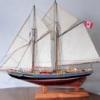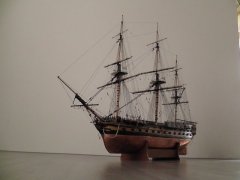-
Posts
2,305 -
Joined
-
Last visited
Reputation Activity
-
 NMBROOK reacted to Siggi52 in HMS Dragon 1760 by Siggi52 - FINISHED - Scale 1:48 - English 74-Gun ship
NMBROOK reacted to Siggi52 in HMS Dragon 1760 by Siggi52 - FINISHED - Scale 1:48 - English 74-Gun ship
Next came the outer skin. Don't worry about the color, I changed that.
-
 NMBROOK reacted to Siggi52 in HMS Dragon 1760 by Siggi52 - FINISHED - Scale 1:48 - English 74-Gun ship
NMBROOK reacted to Siggi52 in HMS Dragon 1760 by Siggi52 - FINISHED - Scale 1:48 - English 74-Gun ship
The next pictures are from the real beginning. I started with a model of the model, to get the feeling. Then I cut the frames in paper and build a shipyard.
When the keel was installed, the Captain fired a canon. After all frames ready, he fired three canon and I had a brandy!
-
 NMBROOK reacted to Siggi52 in HMS Dragon 1760 by Siggi52 - FINISHED - Scale 1:48 - English 74-Gun ship
NMBROOK reacted to Siggi52 in HMS Dragon 1760 by Siggi52 - FINISHED - Scale 1:48 - English 74-Gun ship
Hello everyone,
after I had so much positiv response about the pictures of my model in the gallery, I decided to start a blog about this ship.
About the Dragon is to say, it was a third rate ship, designed by Thomas Slade and build at Deptford. Launched 4.3.1760 and sold 1784.
It is not the first ship model I have build, but the first 18th century and framed model. A friend told me about the Bellona and I'm interested to learn more about these ships. My first name is Siegfried and that name is program, Siegfried was the most famos dragon fighter here in Germany, or the only? So I would build the Dragon. I ordered the plans from the NMM and a lot of books from everywhere. Then I started learning. Because the whole ship would be too large in 1:48, I decided to build only the stern part, from the 10th frame backwards. After 3 month I started with the model.
That was in the winter of 2011/12. In 2012 a friend of mine was in London and I asked him to take pictures from the models at the NMM. That was a great thing and helped me a lot. In 2013 I visited the NMM and the shipyard at Chatham. Here I saw the Superb, the third ship of the Bellona class. That visit changed a lot, you will see it in the pictures. I changed mostly the color of the hull.
I will post the first pictures in a fast pass, to get update with the actual level of work.
And please excuse my english.
Regards,
Siggi
-
 NMBROOK reacted to tarbrush in Mary Rose 1545 by tarbrush - Scale 1:72
NMBROOK reacted to tarbrush in Mary Rose 1545 by tarbrush - Scale 1:72
This will be my first attempt at a build log, hope it comes out looking ok.
Mary Rose has been on my have to model list for a long time but recently Chidokan, on the forum, and I have talked each other into tackling this project. Chidokan will be building a very accurate cross section, mine will be a whole hull model with short cuts for ease of modeling.
I will be using the plans set by David Meagher that I have enlarged to 1:72 scale. What I have in mind is to build one side completely planked but leave the other side partially planked with some view holes cut into the side to see the interior. I would like to include lighting and a crew as well. As for the exterior finish, I love the painting on the cover of "Mary Rose, Your Nobelest Shippe". If I can make decent sails, then, yeah those too. This is without doubt the most ambitious model I have ever tackled. Prior to this I have my models have been mostly small workboats.
While looking on the internet for crew figures I stumbled across this site:
http://www.valdemarminiatures.com/default.asp?Site=Info&page=49
They have the best figures I have ever seen and will be perfect for the Mary Rose, just being able to use these figures will be a treat. They are a bit on the pricey side though and I will wait to order them till I am sure that I can pull this build off.
The Plans:
My research material:
Also an article I downloaded from the internet with some very useful information on framing Mary Rose: The structures of tAtlantic shipbuilding the the 16th century. by Brad Loewen
-
 NMBROOK reacted to JPett in Treenails
NMBROOK reacted to JPett in Treenails
Ahoy Mates
Anyone who follows my builds knows I like treenails. This whole argument about scale amuses me. Really how many rigging components are anywhere near scale; but we all seem to enjoy adding them. Build something you enjoy looking at, not something that is going in a museum as a scale replica, or to meet the expectations of others. Having a treenail out of scale or slightly more visible would not even make the list of mistakes on most builds. Nor would it rate when compared to the mistakes the manufacturer has already built into most kits. Many scratch builder use treenails so we won't even go there
One additional note about treenails: They will strengthen your kit considerably and prevent planks from springing years down the road, which for me makes them worth the effort . Not to mention they can look really good and represent that actual construction method used.
Brought to you by the committee to stop treenail abuse
-
 NMBROOK reacted to JPett in HMS Victory by JPett - Corel - 1:98
NMBROOK reacted to JPett in HMS Victory by JPett - Corel - 1:98
Ahoy Mates
Mike: Thx, I am hoping this will all be gone soon except the experience I gain from it
Dragzz: Please delete some messages, your mailbox is full
Back to the build
Just posting this so I don't forget it. I use my log as a notebook of sorts
While waiting for a plank to soak I decided to address a small gap in the bow planking. It really was not necessary but more of an experiment. I really should have been doing treenails. Originally my plan for these was to use the sawdust and PVA trick when I did my final sanding
They are just little 1/32 by 3/32 scraps sanded into a wedge. Flat tree nails. If I have another opportunity to try this I think I might use a wider piece and put it so the grain follows the planks. The edge grain looks a little dark to do this on any final planking. I have not sanded it yet and it is still wet too. I just snipped them off with my plastic sprue cutters
-
 NMBROOK got a reaction from canoe21 in HMS Victory by JPett - Corel - 1:98
NMBROOK got a reaction from canoe21 in HMS Victory by JPett - Corel - 1:98
Your planking is coming on well JP,you are quite correct,as long as the planking is in full contact with the stern fillers,no worries about how thin you have to take the planking at the sternpost.I think that the fact you are getting clinkering at the bow is a good pointer that you may have to spill some of these planks from sheet when it comes to the second layer to maintain the same line.
Kind Regards
Nigel
-
 NMBROOK reacted to rafine in Frigate Essex by Rafine - FINISHED - Model Shipways - Kitbashed
NMBROOK reacted to rafine in Frigate Essex by Rafine - FINISHED - Model Shipways - Kitbashed
Lower mast construction continues. The fore mast and it's top are now complete and installed. The work included adding the blocks for the spritsail and spritsail topsail yard braces. These are hung below the top and held in place by pegs on the deck of the top. These will be the only blocks that I will attach to the tops, since I do not intend to rig buntlines, leech lines, reef tackles etc.and won't show the blocks for them.
After gluing the top to the mast, I added the bolsters, the jeer sling cleats and the lead blocks for the main topmast stay and preventer stay. Lastly, I permanently mounted the mast.
Work now continues on the main mast and top.
Bob
-
 NMBROOK got a reaction from Ferit in MORDAUNT 1681 by NMBROOK - Euromodel - 1:60 - Beyond Bashed
NMBROOK got a reaction from Ferit in MORDAUNT 1681 by NMBROOK - Euromodel - 1:60 - Beyond Bashed
Thanks Ferit ,I have actually found cobalt drill bits down to 0.15mm diameter now.These have a 1mm shank and would fit in the MF70 collet.Only downside is they aren't cheap
Kind Regards
Nigel
-
 NMBROOK got a reaction from tarbrush in MORDAUNT 1681 by NMBROOK - Euromodel - 1:60 - Beyond Bashed
NMBROOK got a reaction from tarbrush in MORDAUNT 1681 by NMBROOK - Euromodel - 1:60 - Beyond Bashed
Gratings Mk 4 part 2
1.5mm wide battens were glued into the grouves and allowed to dry.I used alaphatic applied with a cocktail stick and excess was vigilently removed with a wet brush.When dry,the back was sanded off and the battens flushed off.I used a small disc in the Proxxon IBE to do this.Before final trimming and profiling I am going to apply two coats of heavily thinned matt poly to prevent any splintering.Mr Frolich does mention this in his book and seems like a good insurance policy.
Kind Regards
Nigel
-
 NMBROOK got a reaction from md1400cs in MORDAUNT 1681 by NMBROOK - Euromodel - 1:60 - Beyond Bashed
NMBROOK got a reaction from md1400cs in MORDAUNT 1681 by NMBROOK - Euromodel - 1:60 - Beyond Bashed
Gratings Mk 4 part 2
1.5mm wide battens were glued into the grouves and allowed to dry.I used alaphatic applied with a cocktail stick and excess was vigilently removed with a wet brush.When dry,the back was sanded off and the battens flushed off.I used a small disc in the Proxxon IBE to do this.Before final trimming and profiling I am going to apply two coats of heavily thinned matt poly to prevent any splintering.Mr Frolich does mention this in his book and seems like a good insurance policy.
Kind Regards
Nigel
-
 NMBROOK got a reaction from Kevin in MORDAUNT 1681 by NMBROOK - Euromodel - 1:60 - Beyond Bashed
NMBROOK got a reaction from Kevin in MORDAUNT 1681 by NMBROOK - Euromodel - 1:60 - Beyond Bashed
Gratings Mk 4 part 2
1.5mm wide battens were glued into the grouves and allowed to dry.I used alaphatic applied with a cocktail stick and excess was vigilently removed with a wet brush.When dry,the back was sanded off and the battens flushed off.I used a small disc in the Proxxon IBE to do this.Before final trimming and profiling I am going to apply two coats of heavily thinned matt poly to prevent any splintering.Mr Frolich does mention this in his book and seems like a good insurance policy.
Kind Regards
Nigel
-
 NMBROOK got a reaction from Bill Hime in MORDAUNT 1681 by NMBROOK - Euromodel - 1:60 - Beyond Bashed
NMBROOK got a reaction from Bill Hime in MORDAUNT 1681 by NMBROOK - Euromodel - 1:60 - Beyond Bashed
Gratings Mk 4 part 2
1.5mm wide battens were glued into the grouves and allowed to dry.I used alaphatic applied with a cocktail stick and excess was vigilently removed with a wet brush.When dry,the back was sanded off and the battens flushed off.I used a small disc in the Proxxon IBE to do this.Before final trimming and profiling I am going to apply two coats of heavily thinned matt poly to prevent any splintering.Mr Frolich does mention this in his book and seems like a good insurance policy.
Kind Regards
Nigel
-
 NMBROOK got a reaction from Mirabell61 in MORDAUNT 1681 by NMBROOK - Euromodel - 1:60 - Beyond Bashed
NMBROOK got a reaction from Mirabell61 in MORDAUNT 1681 by NMBROOK - Euromodel - 1:60 - Beyond Bashed
Gratings Mk 4 part 2
1.5mm wide battens were glued into the grouves and allowed to dry.I used alaphatic applied with a cocktail stick and excess was vigilently removed with a wet brush.When dry,the back was sanded off and the battens flushed off.I used a small disc in the Proxxon IBE to do this.Before final trimming and profiling I am going to apply two coats of heavily thinned matt poly to prevent any splintering.Mr Frolich does mention this in his book and seems like a good insurance policy.
Kind Regards
Nigel
-
 NMBROOK got a reaction from tarbrush in MORDAUNT 1681 by NMBROOK - Euromodel - 1:60 - Beyond Bashed
NMBROOK got a reaction from tarbrush in MORDAUNT 1681 by NMBROOK - Euromodel - 1:60 - Beyond Bashed
Ok then,hopefully a more positive post.After trying the table saw route and more failures(the little nibs kept breaking of)I think I have it sussed.When in doubt,consult a book.After studying Frolich's method,it made a lot of sense when working with the problematic pear.Just a couple of tweaks to use the mill instead of a tablesaw.
So here we have Gratings mark 4?Part one.
A solid block 6mm thick was machined to follow the same pattern as what Frolich does.Basically the ledges are machined in the top face leaving some material acting as a backer holding them the correct distance apart.When the battens are glued and set,the rear face is sanded away leaving a complete grating.The important factor was the order of doing things to prevent the 'nibs' from being chipped.The block was placed in the mill so that the grain followed the ledges i.e.athwartships.1.5mm wide by 1.5mm deep grouves were then cut the right distance apart for the run of the battens.4mm deep by 1.5mm grouves were then machined perpendicular to these.These are the gaps between ledges.I have changed the gap despite what I said earlier to 1.5mm.This then matches the contemporary model,so should not look out of place.This process leaves the ledges attached to a backer which holds everything true while the battens are fitted.The fact that the final cut runs inline with the grain results in crisp 'nibs' with not chipping.I will take photos of the machining process for the next post,I didn't bother while making this until I was sure it would work
Kind Regards
Nigel
-
 NMBROOK reacted to Beef Wellington in HMS Jason by Beef Wellington - Caldercraft - 1:64 - Artois-class frigate modified from HMS Diana 1794
NMBROOK reacted to Beef Wellington in HMS Jason by Beef Wellington - Caldercraft - 1:64 - Artois-class frigate modified from HMS Diana 1794
Decided I really needed to post few pics to show I'm still here. With the weather turning, and the end of the soccer/football season approaching (I coach my son and daughters teams) I can finally foresee more time in the shipyard in the evenings. I had spent a lot of time trying to figure out the deck arrangement, picture are pretty self explanatory and work obviously still in progress. Margin planks are not glued yet, but I did cut my first scarf joint. As mentioned previously, estimating the line of the margin plank required the future shape of the interior bulwark once planked to be estimated - I won't know that I've been successful until its too late.
Unfortunately, at lot of this will not be seen once the quarter deck and forecastle are in place, but its good practice and building my confidence to tackle the more visible top decks.
-
 NMBROOK got a reaction from janos in MORDAUNT 1681 by NMBROOK - Euromodel - 1:60 - Beyond Bashed
NMBROOK got a reaction from janos in MORDAUNT 1681 by NMBROOK - Euromodel - 1:60 - Beyond Bashed
Thank you Mark Btw,I checked EdTs Naiad log,no nails in the gratings,Frolich does say at 1/48 they should be no bigger than 0.2mm.I wouldn't even know where to buy a drill that small,never mind drill more than two holes without it snapping,so that idea has gone in the scrap bin with the other gratings
Kind Regards
Nigel
-
 NMBROOK got a reaction from md1400cs in MORDAUNT 1681 by NMBROOK - Euromodel - 1:60 - Beyond Bashed
NMBROOK got a reaction from md1400cs in MORDAUNT 1681 by NMBROOK - Euromodel - 1:60 - Beyond Bashed
Ok then,hopefully a more positive post.After trying the table saw route and more failures(the little nibs kept breaking of)I think I have it sussed.When in doubt,consult a book.After studying Frolich's method,it made a lot of sense when working with the problematic pear.Just a couple of tweaks to use the mill instead of a tablesaw.
So here we have Gratings mark 4?Part one.
A solid block 6mm thick was machined to follow the same pattern as what Frolich does.Basically the ledges are machined in the top face leaving some material acting as a backer holding them the correct distance apart.When the battens are glued and set,the rear face is sanded away leaving a complete grating.The important factor was the order of doing things to prevent the 'nibs' from being chipped.The block was placed in the mill so that the grain followed the ledges i.e.athwartships.1.5mm wide by 1.5mm deep grouves were then cut the right distance apart for the run of the battens.4mm deep by 1.5mm grouves were then machined perpendicular to these.These are the gaps between ledges.I have changed the gap despite what I said earlier to 1.5mm.This then matches the contemporary model,so should not look out of place.This process leaves the ledges attached to a backer which holds everything true while the battens are fitted.The fact that the final cut runs inline with the grain results in crisp 'nibs' with not chipping.I will take photos of the machining process for the next post,I didn't bother while making this until I was sure it would work
Kind Regards
Nigel
-
 NMBROOK got a reaction from rtropp in MORDAUNT 1681 by NMBROOK - Euromodel - 1:60 - Beyond Bashed
NMBROOK got a reaction from rtropp in MORDAUNT 1681 by NMBROOK - Euromodel - 1:60 - Beyond Bashed
Gratings Mk 4 part 2
1.5mm wide battens were glued into the grouves and allowed to dry.I used alaphatic applied with a cocktail stick and excess was vigilently removed with a wet brush.When dry,the back was sanded off and the battens flushed off.I used a small disc in the Proxxon IBE to do this.Before final trimming and profiling I am going to apply two coats of heavily thinned matt poly to prevent any splintering.Mr Frolich does mention this in his book and seems like a good insurance policy.
Kind Regards
Nigel
-
 NMBROOK reacted to mtaylor in MORDAUNT 1681 by NMBROOK - Euromodel - 1:60 - Beyond Bashed
NMBROOK reacted to mtaylor in MORDAUNT 1681 by NMBROOK - Euromodel - 1:60 - Beyond Bashed
Crap. My apologies Nigel. I thought EdT did the nailing. I'll go stand in the corner and write "check before posting" 100 times.
-
 NMBROOK got a reaction from mtaylor in MORDAUNT 1681 by NMBROOK - Euromodel - 1:60 - Beyond Bashed
NMBROOK got a reaction from mtaylor in MORDAUNT 1681 by NMBROOK - Euromodel - 1:60 - Beyond Bashed
Thank you Mark Btw,I checked EdTs Naiad log,no nails in the gratings,Frolich does say at 1/48 they should be no bigger than 0.2mm.I wouldn't even know where to buy a drill that small,never mind drill more than two holes without it snapping,so that idea has gone in the scrap bin with the other gratings
Kind Regards
Nigel
-
 NMBROOK got a reaction from WBlakeny in MORDAUNT 1681 by NMBROOK - Euromodel - 1:60 - Beyond Bashed
NMBROOK got a reaction from WBlakeny in MORDAUNT 1681 by NMBROOK - Euromodel - 1:60 - Beyond Bashed
Gratings Mk 4 part 2
1.5mm wide battens were glued into the grouves and allowed to dry.I used alaphatic applied with a cocktail stick and excess was vigilently removed with a wet brush.When dry,the back was sanded off and the battens flushed off.I used a small disc in the Proxxon IBE to do this.Before final trimming and profiling I am going to apply two coats of heavily thinned matt poly to prevent any splintering.Mr Frolich does mention this in his book and seems like a good insurance policy.
Kind Regards
Nigel
-
 NMBROOK got a reaction from Ferit in MORDAUNT 1681 by NMBROOK - Euromodel - 1:60 - Beyond Bashed
NMBROOK got a reaction from Ferit in MORDAUNT 1681 by NMBROOK - Euromodel - 1:60 - Beyond Bashed
Gratings Mk 4 part 2
1.5mm wide battens were glued into the grouves and allowed to dry.I used alaphatic applied with a cocktail stick and excess was vigilently removed with a wet brush.When dry,the back was sanded off and the battens flushed off.I used a small disc in the Proxxon IBE to do this.Before final trimming and profiling I am going to apply two coats of heavily thinned matt poly to prevent any splintering.Mr Frolich does mention this in his book and seems like a good insurance policy.
Kind Regards
Nigel
-
 NMBROOK got a reaction from Sjors in MORDAUNT 1681 by NMBROOK - Euromodel - 1:60 - Beyond Bashed
NMBROOK got a reaction from Sjors in MORDAUNT 1681 by NMBROOK - Euromodel - 1:60 - Beyond Bashed
Gratings Mk 4 part 2
1.5mm wide battens were glued into the grouves and allowed to dry.I used alaphatic applied with a cocktail stick and excess was vigilently removed with a wet brush.When dry,the back was sanded off and the battens flushed off.I used a small disc in the Proxxon IBE to do this.Before final trimming and profiling I am going to apply two coats of heavily thinned matt poly to prevent any splintering.Mr Frolich does mention this in his book and seems like a good insurance policy.
Kind Regards
Nigel
-
 NMBROOK got a reaction from Bill Hime in MORDAUNT 1681 by NMBROOK - Euromodel - 1:60 - Beyond Bashed
NMBROOK got a reaction from Bill Hime in MORDAUNT 1681 by NMBROOK - Euromodel - 1:60 - Beyond Bashed
Ok then,hopefully a more positive post.After trying the table saw route and more failures(the little nibs kept breaking of)I think I have it sussed.When in doubt,consult a book.After studying Frolich's method,it made a lot of sense when working with the problematic pear.Just a couple of tweaks to use the mill instead of a tablesaw.
So here we have Gratings mark 4?Part one.
A solid block 6mm thick was machined to follow the same pattern as what Frolich does.Basically the ledges are machined in the top face leaving some material acting as a backer holding them the correct distance apart.When the battens are glued and set,the rear face is sanded away leaving a complete grating.The important factor was the order of doing things to prevent the 'nibs' from being chipped.The block was placed in the mill so that the grain followed the ledges i.e.athwartships.1.5mm wide by 1.5mm deep grouves were then cut the right distance apart for the run of the battens.4mm deep by 1.5mm grouves were then machined perpendicular to these.These are the gaps between ledges.I have changed the gap despite what I said earlier to 1.5mm.This then matches the contemporary model,so should not look out of place.This process leaves the ledges attached to a backer which holds everything true while the battens are fitted.The fact that the final cut runs inline with the grain results in crisp 'nibs' with not chipping.I will take photos of the machining process for the next post,I didn't bother while making this until I was sure it would work
Kind Regards
Nigel












